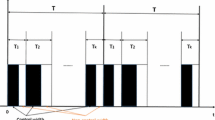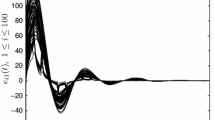Abstract
In this paper, we investigate finite-time synchronization for a class of delayed dynamic networks with hybrid coupling via aperiodically intermittent control. First, more general models of dynamic networks with transmission delay and self-feedback delay are given. Second, a lemma with a newly added parameter is proposed to ensure finite-time synchronization of dynamic networks via an aperiodically intermittent control scheme, in which the newly added parameter can make the convergence time shorter. Third, by constructing a novel piecewise Lyapunov function and applying linear matrix inequality technique, some sufficient conditions ensuring finite-time synchronization for delayed dynamic networks are obtained. Moreover, the convergence time is affected by some decision parameters besides the newly added parameter, one of which is a maximum uncontrolled ratio generated by the definition of aperiodic intermittent control itself. Finally, a numerical example is presented to verify its validity and rationality.







Similar content being viewed by others
References
Strogatz SH (2001) Exploring complex networks. Nature 410:268–276
Boccaletti S, Latora V, Moreno Y, Chavez M, Hwang DU (2006) Complex networks: structure and dynamics. Phys Rep Rev Sect Phys Lett 424:175–308
Albert R, Barabási AL (2002) Statistical mechanics of complex networks. Rev Mod Phys 74:47–97
Wang F, Sun Y (2008) Self-organizing peer-to-peer social networks. Comput Intell 24:213–233
Boccaletti S, Kurths J, Osipov G, Valladares DL, Zhou C (2002) The synchronization of chaotic systems. Phys Rep 366:1–101
Wei G, Jia Y (2002) Synchronization-based image edge detection. Europhys Lett 59:814–819
Xie Q, Chen G, Bollt EM (2002) Hybrid chaos synchronization and its application in information processing. Math Comput Modell 35:145–163
Zhao M, Zhang H, Wang Z, Liang H (2014) Synchronization between two general complex networks with time-delay by adaptive periodically intermittent pinning control. Neurocomputing 144:215–221
Ma X, Wang J (2016) Pinning outer synchronization between two delayed complex networks with nonlinear coupling via adaptive periodically intermittent control. Neurocomputing 199:197–203
Lu J, Chen G (2005) A time-varying complex dynamical network model and its controlled synchronization criteria. IEEE Trans Autom Control 50:841–846
Wu Q, Zhang H, Xu L, Yan Q (2015) Finite-time synchronization of general complex dynamical networks. Asian J Control 17:1643–1653
Yang X, Cao J, Yang Z (2013) Synchronization of coupled reaction–diffusion neural networks with time-varying delays via pinning-impulsive controller. SIAM J Control Optim 51:3486–3510
Wang Z, Jiang Y, Li H (2015) Impulsive synchronization of time delay bursting neuron systems with unidirectional coupling. Complexity 21:38–46
Liu X, Chen T (2011) Cluster synchronization in directed networks via intermittent pinning control. IEEE Trans Neural Netw 22:1009–1020
Mei J, Jiang M, Xu W, Wang B (2013) Finite-time synchronization control of complex dynamical networks with time delay. Commun Nonlinear Sci Numer Simul 18:2462–2478
Luo M, Zhang J (2009) Event-driven service oriented framework for integrative serviceability management of networked manufacturing systems. In: 2009 IEEE/ASME international conference on advanced intelligent mechatronics, Suntec Convention and Exhibition Center, Singapore, July 14–17, pp 392–397
Jeeva Sathya Theesar S, Balasubramaniam P (2014) Secure communication via synchronization of Lure systems using sampled-data controller. Circuits Syst Signal Process 33:37–52
Jing T, Chen F (2016) Finite-time lag synchronization of delayed neural networks via periodically intermittent control. Complexity 21:211–219
Mei J, Jiang M, Wang X, Han J, Wang S (2014) Finite-time synchronization of drive-response systems via periodically intermittent adaptive control. J Frankl Inst 351:2691–2710
Zhang D, Shen Y, Mei J (2017) Finite-time synchronization of multi-layer nonlinear coupled complex networks via intermittent feedback control. Neurocomputing 225:129–138
Zhang W, Li C, Huang T, Xiao M (2015) Synchronization of neural networks with stochastic perturbation via aperiodically intermittent control. Neural Netw 71:105–111
Zhang W, Yang S, Li C, Zhang W, Yang X (2018) Stochastic exponential synchronization of memristive neural networks with time-varying delays via quantized control. Neural Netw 104:93–103
Liu X, Chen T (2015) Synchronization of linearly coupled networks with delays via aperiodically intermittent pinning control. IEEE Trans Neural Netw Learn Syst 26:2396–2407
Cai S, Liu Z, Xu F, Shen J (2009) Periodically intermittent controlling complex dynamical networks with time-varying delays to a desired orbit. Phys Lett A 373:3846–3854
Li C, Chen G (2004) Synchronization in general complex dynamical networks with coupling delays. Phys A 343:263–278
Zhou J, Chen T (2006) Synchronization in general delayed dynamical networks. IEEE Trans Circuits Syst I Regul Pap 53:733–744
Cao J, Chen G, Li P (2008) Global synchronization in an array of delayed neural networks with hybrid coupling. IEEE Trans Syst Man Cybern 38:488–498
Oguchi T, Nijmeijer H, Yamamoto T (2008) Synchronization in networks of chaotic systems with time-delay coupling. Chaos 18:037108
He W, Cao J (2010) Exponential synchronization of hybrid coupled networks with delayed coupling. IEEE Trans Neural Netw 21:571–583
Zhang W, Tang Y, Fang J, Zhu W (2011) Exponential cluster synchronization of impulsive delayed genetic oscillators with external disturbances. Choas 21:043137
Wong WK, Zhang W, Tang Y, Xu X (2013) Stochastic synchronization of complex networks with mixed impulses. IEEE Trans Circuits Syst I Regul Pap 60:2657–2667
Huang C, Lu J, Ho DWC, Zhai G, Cao J (2020) Stabilization of probabilistic Boolean networks via pinning control strategy. Inf Sci 510:205–217
Li Y, Lou J, Wang Z, Alsaadi FE (2018) Synchronization of dynamical networks with nonlinearly coupling function under hybrid pinning impulsive controllers. J Frankl Inst 355:6520–6530
Wan X, Yang X, Tang R, Cheng Z (2019) Exponential synchronization of semi-Markovian coupled neural networks with mixed delays via tracker information and quantized output controller. Neural Netw 118:321–331
Yang X, Cao J (2010) Finite-time stochastic synchronization of complex networks. Appl Math Model 34:3631–3641
Bowong S, Kakmeni M, Koina R (2006) Chaos synchronization and duration time of a class of uncertain chaotic systems. Math Comput Simul 71:212–228
Wang H, Ye J, Miao Z, Jonckheere EA (2016) Robust finite-time chaos synchronization of time-delay chaotic systems and its application in secure communication. Trans Inst Meas Control 40:1177–1187
Wang X, Liu X, She K, Zhong S (2017) Finite-time lag synchronization of master–slave complex dynamical networks with unknown signal propagation delays. J Frankl Inst 354:4913–4929
Zhang W, Yang X, Xu C, Feng J, Li C (2018) Finite-time synchronization of discontinuous neural networks with delays and mismatched parameters. IEEE Trans Neural Netw Learn Syst 29:3761–3771
Zhang D, Mei J, Miao P (2017) Global finite-time synchronization of different dimensional chaotic systems. Appl Math Model 48:303–315
Jing T, Zhang D, Mei J, Fan Y (2019) Finite-time synchronization of delayed complex dynamic networks via aperiodically intermittent control. J Frankl Inst 356:5464–5484
Li B (2014) Finite-time synchronization for complex dynamical networks with hybrid coupling and time-varying delay. Nonlinear Dyn 76:1603–1610
Liu M, Jiang H, Hu C (2017) Finite-time synchronization of delayed dynamical networks via aperiodically intermittent control. J Frankl Inst 354:5374–5397
Fan Y, Liu H, Zhu Y, Mei J (2016) Fast synchronization of complex dynamical networks with time-varying delay via periodically intermittent control. Neurocomputing 205:182–194
Author information
Authors and Affiliations
Corresponding author
Additional information
Publisher's Note
Springer Nature remains neutral with regard to jurisdictional claims in published maps and institutional affiliations.
This research was supported by the Doctoral Foundation of Henan Polytechnic University 761107/011), and Scientific Research Foundation for the Staff of Xinhua College of Sun Yat-sen University (2019KYQN14).
Appendix
Appendix
Proof of Lemma 4
Denote \(M_0=V^{1-\kappa }(0)+\frac{\varsigma }{\nu _1}\) and \(W(t)=\exp \{(1-\kappa )\nu _1t\}V^{1-\kappa }(t),~\text{ for }~t\ge 0\). Let \(Q(t)=W(t)-M_0+\frac{\varsigma }{\nu _1}\exp \{(1-\kappa )\nu _1t\}\). It is easy to see that \(Q(t)=0,~~\text{ for }~~t=0.\)
In the following, we will prove that \(Q(t)\le 0,~~\text{ for }~~t\in [0,s_0).\)
For \(\forall t\in [0,s_0)\), it has
Hence, \(Q(t)\le Q(0)=0,~~\text{ for }~~t\in [0,s_0).\)
Let \(W_1(t)=\exp \{(1-\kappa )\nu _1t\}\exp \{-(1-\kappa )(\nu _1+\nu _2)(t-s_0)\}V^{1-\kappa }(t)=\exp \{(1-\kappa )\nu _1s_0\}\exp \{-(1-\kappa )\nu _2(t-s_0)\}V^{1-\kappa }(t)\), \(Q_1(t)=W_1(t)-M_0+\frac{\varsigma }{\nu _1}\exp \{(1-\kappa )\nu _1t\}\exp \{-(1-\kappa )(\nu _1+\nu _2)(t-s_0)\}=W_1(t)-M_0+\frac{\varsigma }{\nu _1}\exp \{(1-\kappa )\nu _1s_0\}\exp \{-(1-\kappa )\nu _2(t-s_0)\}.\) Next, we will prove that for \(t\in [s_0,t_1),~Q_1(t)\le 0.\)
For \(\forall t\in [s_0,t_1)\), we can obtain
Hence, \(Q_1(t)\le Q_1(s_0)=Q(s_0)\le 0.\)
Together with \(Q_1(t)\le 0\), for \(t\in [s_0,t_1)\), we can obtain
Note that \(Q(t)\le 0\), for \(~t\in [0,s_0)\), we have
So, for \(t\in [0,t_1)\), it has
Similarly, we can prove that for \(t\in [t_1, s_1)\),
Suppose
It is easy to prove that \(Q_2(t)\le 0\), \(\forall t\in [t_1, s_1)\).
For any \(t\in [s_1, t_2)\), by taking \(W_2(t)=W(t)\exp \{-(1-\kappa )(\nu _1+\nu _2)(t_1-s_0)\}\exp \{-(1-\kappa )(\nu _1+\nu _2 )(t-s_1)\}=\exp \{(1-\kappa )\)\(\nu _1(s_0+s_1-t_1)\}\exp \{-(1-\kappa )\nu _2(t-(s_0+s_1-t_1))\}V^{1-\kappa }(t)\) and \(Q_3(t)=W_2(t)-M_0+\frac{\varsigma }{\nu _1}\exp \{(1-\kappa )p_1t\}\exp \{-(1-\kappa )(\nu _1+\nu _2 )(t_1-s_0)\}\)\(\exp \{-(1-\kappa )(\nu _1+\nu _2 )(t-s_1)\}=W_2(t)-M_0+\frac{\varsigma }{\nu _1}\exp \{(1-\kappa )\nu _1(s_0+s_1-t_1)\}\exp \{-(1-\kappa )\nu _2(t-(s_0+s_1-t_1))\}\), we can verify \(Q_3(t)\le Q_3(s_1)\le 0\) similar to the proof of \(Q_1(t)\le 0,~t\in [s_0,t_1).\)
Therefore,
and
By induction, for any integer m, we can deduce the following estimation of W(t) for any t.
For \(t_m\le t<s_m\), we can get
and for \(s_m\le t<t_{m+1}\), we can get
For \(t_m\le t<s_m\), by applying Definition 2, it has
For \(s_m\le t<t_{m+1}\), by applying Definition 2 and Lemma 1, it has
From the definition of W(t), we can obtain
With Lemma 3, the settling time \(T^*\) can be obtained in the following form \(V^{1-\kappa }(0)+\frac{\varsigma }{\nu _1}=\frac{\varsigma }{\nu _1}\exp \{(1-\kappa )\nu _1T^*\}\exp \{-(1-\kappa )(\nu _1+\nu _2)\Psi T^*\}\).
From (10), one can obtain that
The proof is completed. \(\square \)
Rights and permissions
About this article
Cite this article
Jing, T., Zhang, D. & Jing, T. Finite-Time Synchronization of Hybrid-Coupled Delayed Dynamic Networks via Aperiodically Intermittent Control. Neural Process Lett 52, 291–311 (2020). https://doi.org/10.1007/s11063-020-10245-4
Published:
Issue Date:
DOI: https://doi.org/10.1007/s11063-020-10245-4




